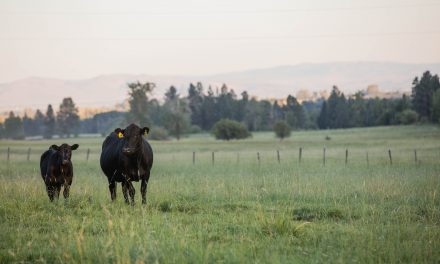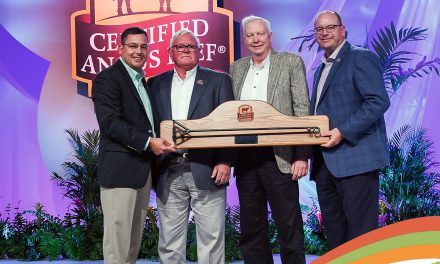“How do they do that?” you ask. By raising cattle—premium Angus cattle.


In the midst of the rugged Superstition Mountains east of Phoenix, Ariz., you’ll find Chuck Backus’ Quarter Circle U Ranch. It’s a place painted with canyons, rocks and cactus at varying elevations, from 2,000 to 4,000 feet, and when Backus first came here, there had been no water development for the past 100 years.
“When I first bought the ranch more than 35 years ago, I had a primary focus of increasing the condition of the range, which, in the past, had been abused,” he says.
To begin healing the land, Backus consulted a soil conservationist. Although they knew the topography and arid climate meant it would never be the spot for vegetables, feed or food grains, the men were able to turn it into a sustainable home for more than 300 head of cattle.
In 1979, it became the first ranch to be completely solar powered. Cross fencing, the use of fence to divide larger areas of ground, allowed Backus to rotate his herd, which ultimately helped improve the land. Major improvements were made for corral water storage and distribution, and a summer pasture reserved for the harsh, dry season protected the other grazing areas. Specifically for the herd, the best Angus genetics now maximize the amount of quality protein the cattle provide.
“Today, the soil is better, which means the quality of food coming off the land is better,” Backus says, speaking to the tasty beef he provides for consumers around the country, including Certified Angus Beef ® brand Natural: product raised with no antibiotics or added hormones, ever.



At the other end of the North American climate spectrum, the Hamiltons of Cochrane, Alberta, and the Skinners of Hall, Montana, face very different obstacles.
“We have a short growing season here. It doesn’t start to warm up until May and then it starts cooling down in September,” Tim Skinner says. The mountainous terrain of western Montana adds an extra challenge for some farming enterprises.
The sharply inclined and forest-covered ground doesn’t bother the cattle. During the summer months, they find solace grazing on the lush grasses that grow on the slopes and shade under the many evergreen trees prominent on the land. The Skinners are happy to let the cattle make this land, surrounded by national forests, their home. They know crop farming on the vertically challenging landscape would be practically impossible. In addition, the trees stay—a bonus for the environmentally conscious family.
In Canada, snow causes the most setbacks for the Hamiltons, with only a few snow-free months in Cochrane offering some relief. When the snow does melt, it’s a very short window for cattle to graze freely, or ranchers to grow crops and feedstuffs. The wintery temperatures also make for frigid, midnight calls if a heifer needs assistance when it’s her time to deliver a calf.
“The winters here can be taxing,” Gail Hamilton admits, but the herd thrives because Angus cattle are so adaptable and originated at similar latitudes in Scotland. Hamilton adds that pleasant thoughts of riding up on the hills in the spring to check on the calves keeps her family motivated through each winter.
“Why do they do it?” you ask. Passion—and lots of it.
“[Ranching] is very hard work, but we take a lot of pride in what we do, to give the best care to these animals and this land, and to provide safe and delicious beef for consumers,” Skinner says. “We wouldn’t do it if we were just ‘chasing the almighty dollar’ like some people think we are. There are certainly easier ways to make a living that don’t require going out in zero degree temperatures to help a cow calve in the middle of the night.”




